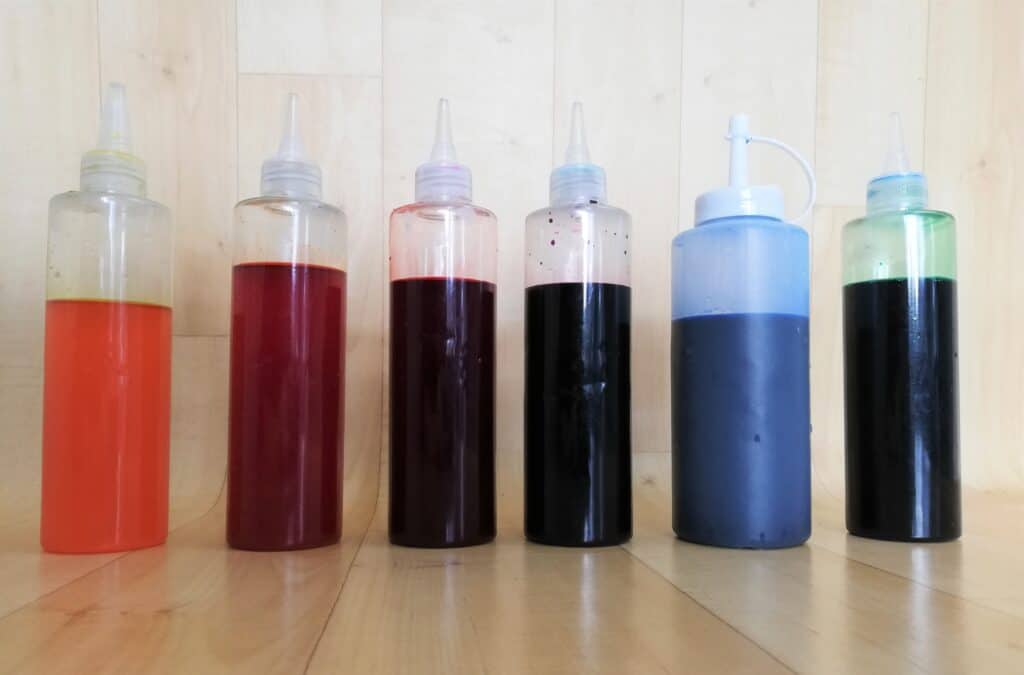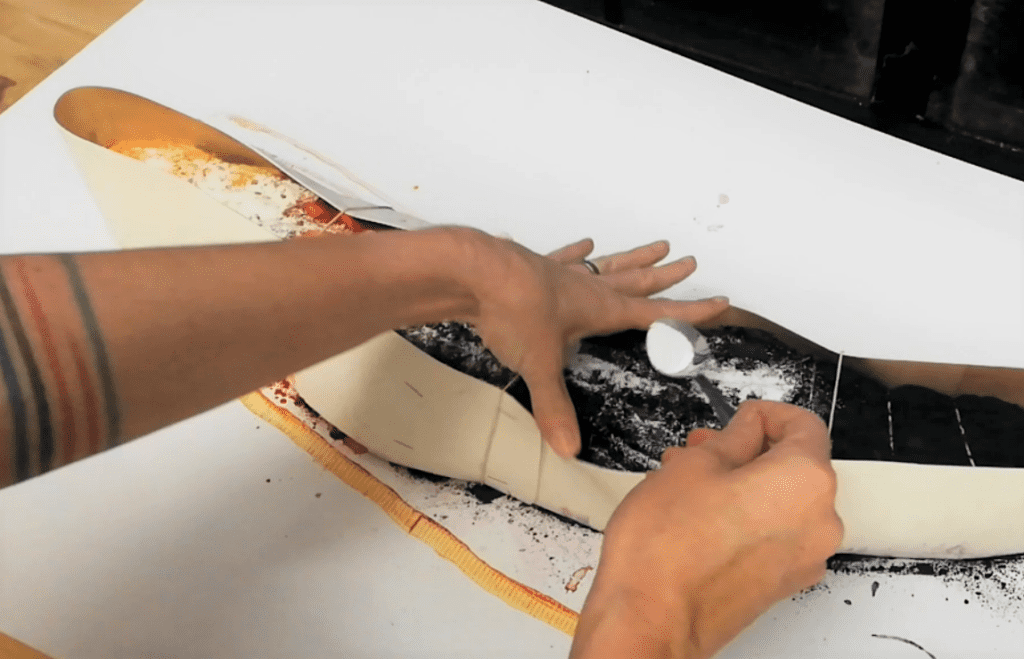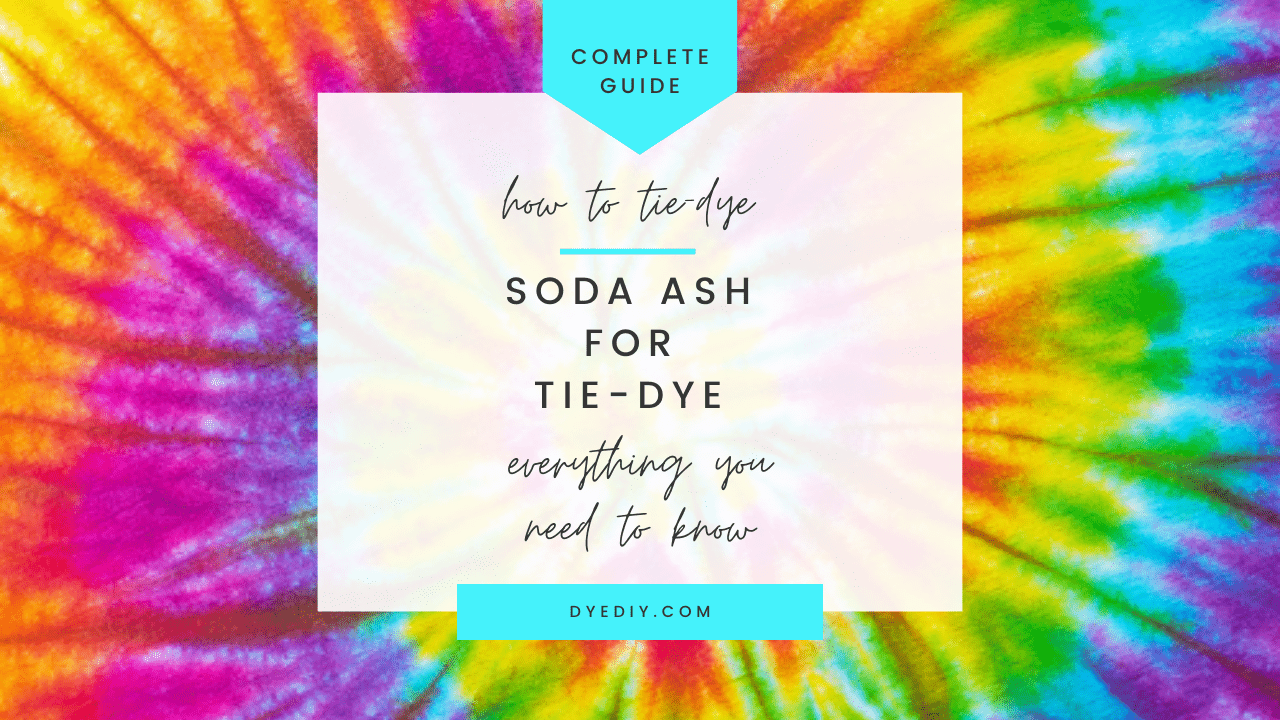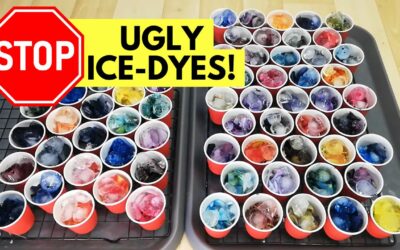This post contains affiliate links, which means I may earn a commission (at no extra cost to you) if you click through and purchase. As an Amazon affiliate I earn from qualifying purchases. Thanks for your support. Read the full disclaimer.
Ah, soda ash – totally necessary for tie-dye yet totally mysterious to many!
This guide will tell you everything you need to know about using soda ash for tie-dye – even if you slept through chemistry class.

You’ll learn what it is, how (and why) it works, and how to use it in all sorts of different tie-dye techniques.
As usual, we’re talking about fiber-reactive dyes, like Procion. If you’re using other dyes soda ash may or may not work.
OK, let’s get started.
What is soda ash?
Soda ash is sodium carbonate – Na2CO3.
In tie-dyeing, soda ash helps the dye to stick.
It enables the dye molecules to bond permanently with the fabric molecules by providing an alkaline pH of 10.5 – 11.
So whenever you use soda ash you have to think of how it’s reaching both the dye and the fabric, and helping the dye stick to the fabric.
Soaking fabric before applying dye = dye will bond as soon as it hits the fabric
Mixing with dye = dye will bond as soon as it hits the fabric
Sprinkling over an ice dye = dye will soak through fabric, spread and blend, then the soda ash will bond it to the fabric
Adding soda ash solution to low water immersion = dye will soak through fabric, spread and blend, then the soda ash will bond it to the fabric
If you begin thinking of it like that you can see the possibilities, while also making sure it’s a practical way to use it.
Tie-dyeing with soda ash
Now, let’s look at some practical ways to use soda ash.
SAFETY NOTE!
Soda ash is mildly caustic (remember the pH above?) and can irritate skin and airways. Always wear gloves and a mask when handling soda ash or anything you have soaked in the solution.
How to pre-soak tie-dye
The most common way to apply soda ash is to pre-soak, and it’s pretty simple. In fact, I cover the entire process in just a couple of minutes in this video!
The video gives you a few tricks to make your soda ash solution quickly and easier, but if you prefer to read here are the basic instructions.
- Soda ash ratio – Add 1 cup of soda ash to 4 litres of warm water
- Mix well until it’s dissolved
- Soak the items to be dyed in the solution for at least twenty minutes
- Wring, spin, or completely dry the item before applying the dye
I use a large bucket with a lid. Plastic crates also work well. Anything over about 10L will provide enough space for a decent day of dyeing projects.

You can use soaked items for liquid dyeing or ice dyeing. The dye will bond almost immediately to the fabric.
Should you tie before or after soaking? Either way works, it’s your choice.
You can leave the items to soak for a long time, they don’t degrade. Mine usually sit there for weeks before I get around to them. Some people even soak, dry, then fold up and store for when they’re ready to tie-dye.
Finally, you can keep the soda ash solution indefinitely – I simply top mine up when it gets low.
Mixing liquid dye with soda ash
You can also add soda ash directly to your dye liquid, and it’s pretty quick and easy.
- Soda ash to dye ratio: 1 tsp of soda ash (8g) for each cup of dye (250mL)
- You will need warm water to dissolve it properly.
Once it’s mixed you can apply the dye as normal.
However, you can’t store the mixed dye – you’ll need to use it in a single dye session.

Ice-dyeing with soda ash
You have a couple of options with ice-dyeing.
- Soak your item in soda ash solution, dry or part-dry, then fold and apply ice and dye. You can leave it at that, or sprinkle a little more soda ash powder on top – just to be safe.
- Don’t soak your item. Apply dye and ice, and also apply soda ash. You can mix soda ash with the dye, or layer one above and one below the dye.
- Don’t soak your item. Apply dye and ice. When it’s melted, irrigate using the instructions below, OR apply another layer of ice with soda ash. These methods work well if you’re using a lot of dye, as one layer of ice usually won’t be enough to dissolve all the dye.

How about just freezing the soda ash ice cubes?! Genius idea, right?
Yeah, I thought that too, but I was wrong – it must lower the freezing point because it doesn’t freeze properly, and I had slushy mush.
Where do I buy soda ash?
Soda ash can be tricky to find.
You can buy it in laundry sections of supermarkets, but you need to ensure that it is pure sodium carbonate – it can often have optical whiteners, scents, or other additives.
Arm & Hammer is commonly used in North America.
In Australia I buy Lectric Soda (as featured on A Current Affair – must be good, right?!) from any supermarket.
Pool supply stores usually sell it in larger amounts, but it’s not always cheaper in bulk.
If you can’t find anywhere locally, you can order online.
Help! I forgot to add soda ash!
So you’ve tied your item, added your dye….then stepped back and realised that you didn’t add soda ash and if you don’t fix it SOMEHOW your lovely dye pattern will just rinse out.
Eek!
Luckily, it’s a pretty easy fix.
- Make a concentrated soda ash solution of 1 part soda ash to 2 parts hot water (eg 1/2 cup soda ash to 1 cup water)
- Irrigate your dyed item slowly. Needle-nose bottles are great for this.
- Irrigate until it’s saturated, but not running freely
- Repeat every 10 minutes, 3 times
- Let it sit in a warm place for at least 6 hours for the reaction to complete.
You can do this with liquid dyes or ice dyes, and the finished product should be just as good as if you hadn’t been absent-minded 😉
Can I make soda ash from baking soda?
Yes, you can.
Essentially, baking soda is sodium bicarbonate, while soda ash is sodium carbonate.
Or in chemistry terms, NaHCO₃ and Na₂CO₃.
You might be wondering if the minor difference in elements actually makes a difference.
The answer, in chemistry, is yes.

So no, they’re not the same, and you can’t use baking soda to set tie-dye, because it’s not alkaline enough.
But when sodium bicarbonate is heated it decomposes to sodium carbonate – soda ash.
So yes, it can be done, and many people do it.
But my question is, why bother?
Just buy soda ash. It’s much less complicated, and you know it’s all soda ash, not a mix of soda ash and non-decomposed baking powder.
Mr. Tie-Dye has a tutorial about making soda ash from baking powder if you’re still keen to try it.
Should I mix soda ash with dry dye?
If you’re ready to dye with that dye, yes, you can.
Use a ratio of 1:1
Then you can use this to mix up liquid dye (remember, you’ll need to add double the dye as it’s half as concentrated), or apply to ice dyes.
If you’re storing them, no!
Soda ash fixes the dyes. It causes the reaction to happen that bonds the dyes to the fabric. Therefore you DON’T want to mix it in to your dry dyes because any reaction will reduce the effectiveness of the dye – and dampness or humidity will destroy it.
This is why Tulip kits and others like them have a shorter shelf life than pure dyes.
How long can you leave shirts in soda ash?
As long as you need. I have left shirts and other items in soda ash for months and they’ve been perfectly fine – the soda ash won’t harm them.
Many dyers soak their shirts, line-dry them, and store them in a cupboard until they’re ready to dye.
And there you have it!
Hopefully that answers all your soda ash related questions, and now you understand how it works you can predict and experiment with great results.
If you have any more please drop them in the comments, and I’ll update the post with answers.






Thanks for the info! You’re awesome!!
Thank you!
Good read BUT you forgot to mention that soda ash is the fixative for only one type of dye that only works on cellulose (plant) fibres….. so many novice tie dyers will read this and not get that no amount of soda ash will make the dyes stick to polyester….
Hi Lynne, it’s mentioned in the intro but you’re right, it’s probably worth mentioning it a few more times through the post and making it really obvious. Thanks!
So how do you get dye to stick to polyester please
Hi Gayle,
You need a different type of dye. I’ve used Jacquard iDye Poly with good results – the red did go more pink though, so be careful there!
https://amzn.to/3WF7c6J
Cheers,
Kelly.
Hello! I read somewhere that soda ash should not be used with aluminum or zinc. Do you have any experience with this? My sink is well.. zinc so, maybe I should not soak it in there..
Hi, I’m not exactly sure, but this article covers it well. It says it corrodes some plastics, aluminum, lead, and zinc. BUT it’s all at very high concentrations – we don’t use anything close to a 35% solution.
https://www.corrosionpedia.com/definition/2782/sodium-carbonate
I use it with plastic buckets and stainless steel without any issues. If I were you I’d use a cheap plastic bucket or container to soak, and keep an eye on it. You could do a spot test on your sink (maybe underneath) if you really want to use it.